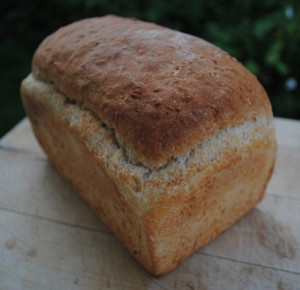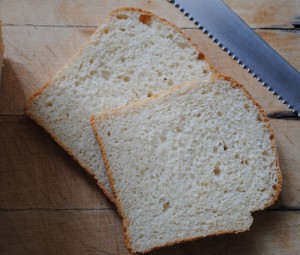Rice bread, or, The Rectory Receipt
Recently I’ve been experimenting with rice bread using a recipe that I first encountered in Eliza Acton’s English Bread Book of 1857. Acton called it ‘The Rectory Receipt’ (receipt being a now-archaic word for recipe; both derive from the Latin recipere, which can mean ‘to take back’ or ‘to receive’).
Acton attributes the recipe to a country parson’s wife, who remains nameless. Acton herself admitted that she had not actually tested the recipe, rather a rash move for someone writing for publication. She was obviously persuaded that it was a worthwhile one, though, and gives detailed directions in the lady’s own words. By modern standards the process was incredibly elaborate (preparing the rice alone took several days!), and the amounts are for batch baking large numbers of loaves. A little over a century later, Elizabeth David reinterpreted the recipe for the domestic baker of her day, making it a lot more accessible.
Essentially it simply involves mixing a quantity of cooked rice with flour and proceeding to make a straightforward lean bread dough which is proved and baked in a loaf tin. The parson’s wife informs us that her reason for doing this originally was that it added bulk to the household’s bread at a time when flour was very expensive. She notes, however, that she was so pleased with the results that she continued to use rice even after the price dropped.
David’s version is actually an amalgamation of the Rectory Receipt and another recipe from the period, care of a Lady Llanover, which contains a lower proportion of rice:
85g uncooked rice (I used basmati)
Approx 3 times the same volume of water for cooking
500g strong bread flour
250ml water
15g fresh yeast
15-20g salt
I substituted 7g of fast-action yeast and cut the salt to 5g (older recipe books always advise more salt than is considered healthy these days; I normally use 1% as a baker’s percentage). After the rice is cooked, but while still warm, it is mixed into the flour along with the other ingredients. The original recipe doesn’t stipulate kneading the dough as such. The parson’s wife says only that the initial ingredients should be combined and liquid baker’s yeast (the recipe pre-dates compressed yeast) added: ‘…beat it in well with the hand, and knead it about.’ David also observes that ‘this dough requires very little kneading’. I hardly worked the dough at all, just mixed it thoroughly.
David’s formulation produced a very sticky dough, and more volume than my loaf tin could handle. The resulting loaf didn’t rise well, though I imagine it would have done better in a larger container. After 40 minutes in the oven it appeared to be baked-through, but the crumb felt gummy and cloying, although the structure was good. I decided to try again, reducing the overall volume and the proportion of water in the initial mix.
65g rice
195g water for cooking
400g flour
160g water for the dough
4g salt
7g yeast
This time the dough started out relatively stiff, though tacky. I started kneading it but within 5 minutes I stopped, as the dough was quickly becoming more fluid and sticky – the opposite of what you might normally expect. After an hour’s bulk fermentation the dough was very soft and sticky indeed, and extra flour was needed to be able to shape it for the tin. I guessed that this was caused by the moisture in the rice dispersing into the dough. During cooking the rice absorbs much of the water and, although not all of this water will be taken in by the dough, it will add considerably to the initial hydration.
The prove took a little less than an hour, and in the oven preheated to 230°c the dough swelled rapidly to give a well-formed loaf.
 So far I have assumed that the rice provides a slow-release source of water for the dough. It must also retain moisture in the dough during baking. It would be interesting to understand more about how the rice affects the dough but, without the necessary knowledge or tools, that job will have to fall to someone else.
So far I have assumed that the rice provides a slow-release source of water for the dough. It must also retain moisture in the dough during baking. It would be interesting to understand more about how the rice affects the dough but, without the necessary knowledge or tools, that job will have to fall to someone else. The resulting bread was much more successful, with a good crumb texture, thin crust, and a slightly sweet flavour. The presence of the rice itself is hardly noticeable. The crumb is slightly moister than you would expect from a regular sandwich loaf. David explains that this also gives it enhanced keeping properties – by this I guess she means that it will take longer to go stale, although it could also encourage mold if not stored properly. My loaf didn’t last long enough for me to test this; it’s a bread I will certainly be making again.
The resulting bread was much more successful, with a good crumb texture, thin crust, and a slightly sweet flavour. The presence of the rice itself is hardly noticeable. The crumb is slightly moister than you would expect from a regular sandwich loaf. David explains that this also gives it enhanced keeping properties – by this I guess she means that it will take longer to go stale, although it could also encourage mold if not stored properly. My loaf didn’t last long enough for me to test this; it’s a bread I will certainly be making again.
